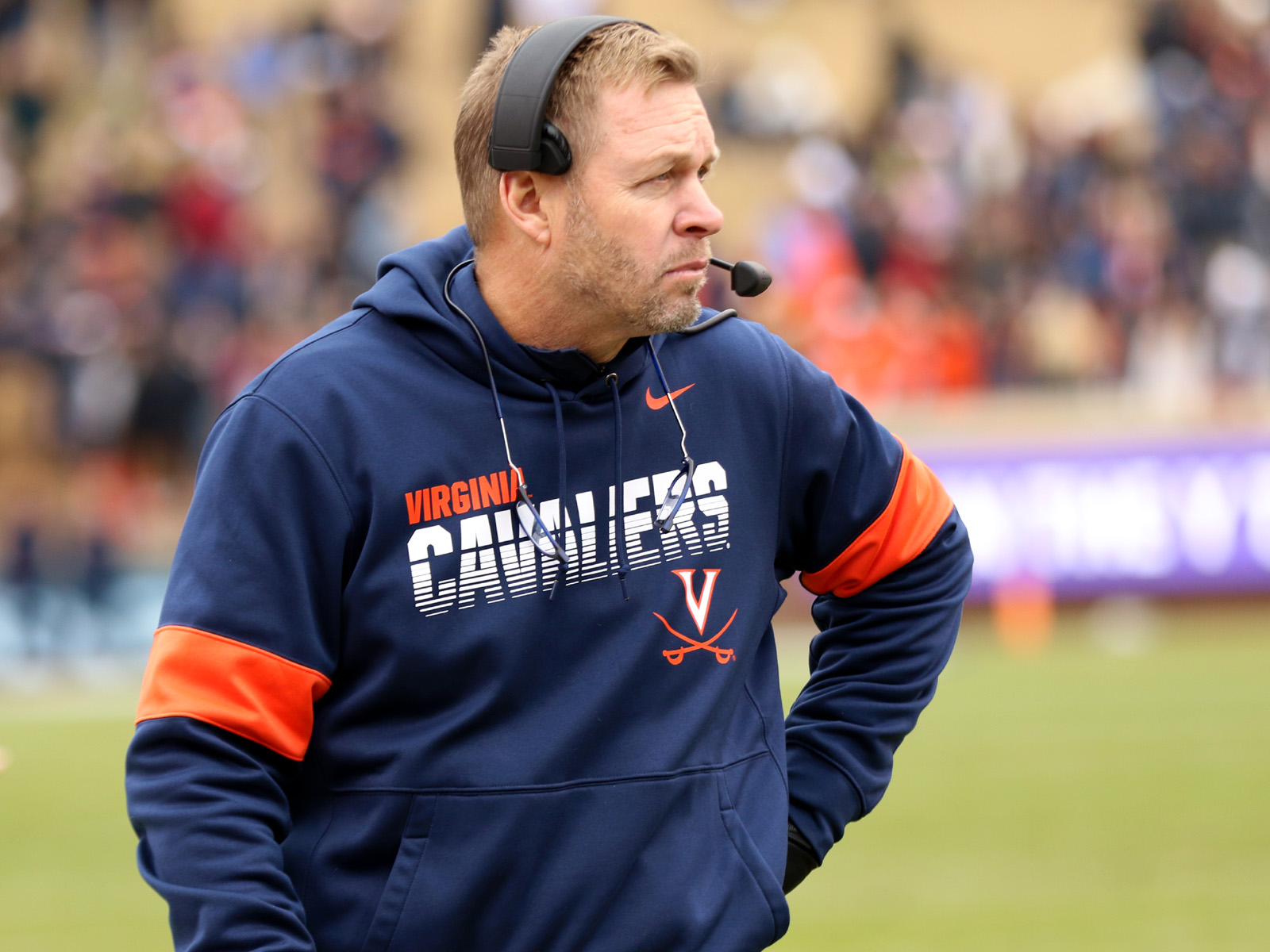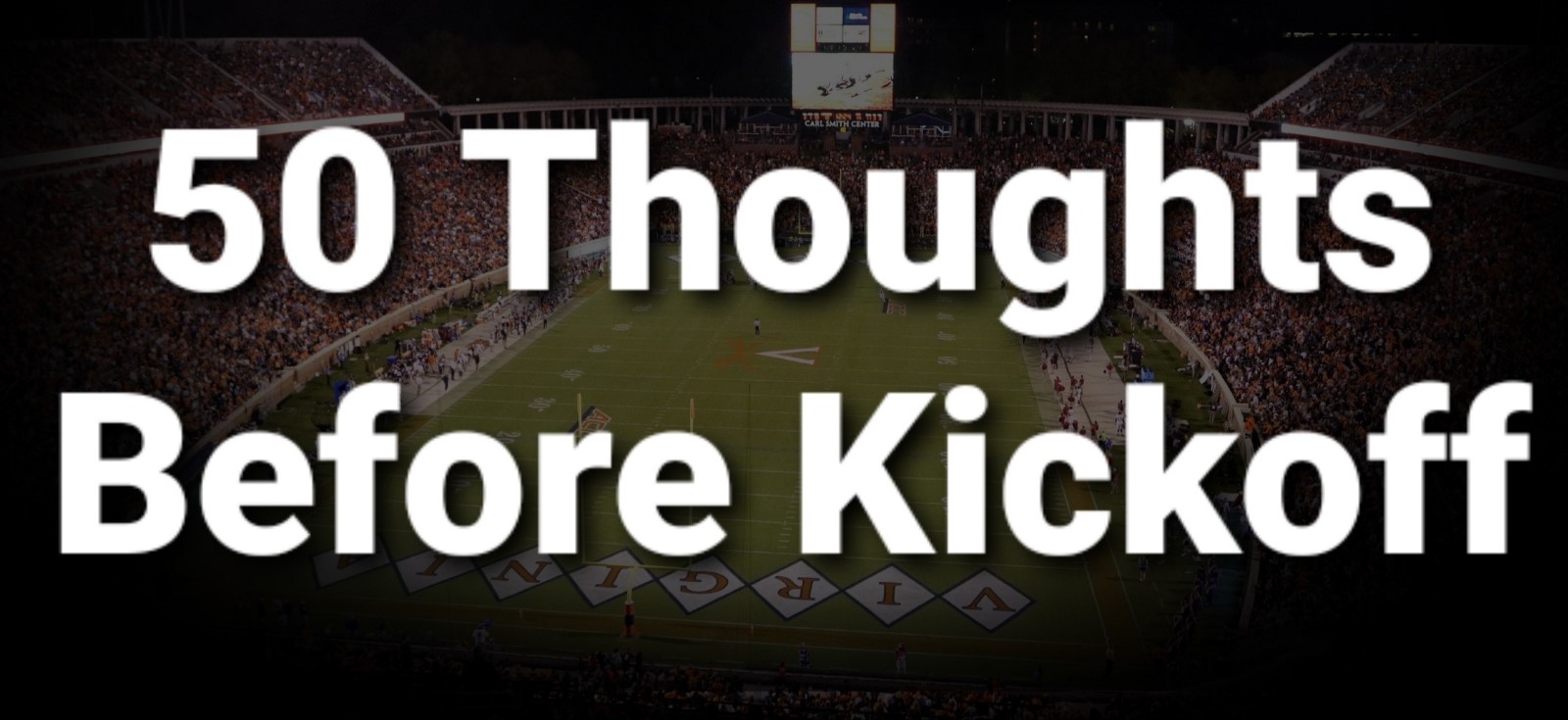
In August of 2016 I wrote a four-story series entitled Four Trends Bronco Mendenhall Must Break For Virginia Football. The story focused on four leading factors (among dozens) that I felt were necessary for the new head coach to alter if Virginia were to begin winning with any consistency again.
 Five years in, let’s look back at the four trends as part of the “50 Thoughts Before Virginia Football Kickoff” series. We’ll again break it into four parts. Part 1 is here. Part 2 is here.
Five years in, let’s look back at the four trends as part of the “50 Thoughts Before Virginia Football Kickoff” series. We’ll again break it into four parts. Part 1 is here. Part 2 is here.
First, a reminder on the four trends I thought had premium importance.
- Losing the field position fight
- Offensive inefficiency – lack of explosiveness and the quarterback carousel
- Defensive adaptation – inability to defend the emergence of college spread offenses
- Establishing a defined program culture
Defensive adaptation – inability to defend the emergence of college spread offenses
This has been an area where progress has been inconsistent and cannot be classified as an area where the trend has stopped. In fact, it has worsened. Mike London’s final five teams ranked better than Mendenhall’s defenses in Opponent Average Team Passing Rating (TPR – 132.32 to 135.14), Drive Yards Allowed per Offensive Play (DYPP – 64.2 to 75.6), Yards Per Attempt (YPA – 6.28 to 7.9), and in Chunk Pass Plays Allowed (42.8 to 46.2 annually).
Over the 10-year span from 2011-2020, individual seasons from 2015-2020 owned the following:
- Opponents Average Team Passing Rating – No. 1, 3, & 4 highest seasonal numbers
- Drive Yards Allowed Per Offensive Play – No. 1, 2, & 5 highest seasonal numbers
- Yards Per Attempt Allowed – No. 1, 2, & 4 highest seasonal numbers
- Chunk Plays Allowed – No. 1, 2 & 3 highest seasonal numbers
The TPR indicates how efficient opposing offense’s passing games are during a game. Drive yards are calculated as the difference between starting field position and ending field position on offensive possessions and DYPP is drive yards allowed per offensive play. Finally, the YPA is the yards gained per pass based on yards gained divided by total passes thrown.
| Opp TPR | Rank | DYPP | Rankings | Yards per att | Ranking | Chunk Pass Plays allowed | Ranking | |
|---|---|---|---|---|---|---|---|---|
| 2011 | 125.7 | 43 | 5.49 | 58 | 6.8 | 45 | 54 | 124 |
| 2012 | 129 | 51 | 5.21 | 29 | 6.3 | 23 | 33 | 28 |
| 2013 | 129.7 | 67 | 6.07 | 97 | 7.2 | 69 | 43 | 75 |
| 2014 | 124.4 | 42 | 5.23 | 32 | 7.1 | 69 | 36 | 40 |
| 2015 | 152.9 | 115 | 6.39 | 105 | 8.2 | 108 | 48 | 101 |
| Average /seaaon | 132.34 | 63.6 | 5.678 | 64.2 | 7.12 | 62.8 | 42.8 | 73.6 |
| Last 4 years | 134 | 68.75 | 5.75 | 65.75 | 7.2 | 67.25 | 40 | 61 |
| Last three years | 135.6 | 74.6 | 5.89 | 78 | 7.5 | 82 | 42.3 | 72 |
| Opp TPR | Rank | DYPP | Rankings | Yards per att | Ranking | Chunk Pass Plays allowed | Ranking | |
| 2016 | 147.8 | 108 | 6.48 | 104 | 8.5 | 117 | 50 | 113 |
| 2017 | 120.2 | 33 | 5.54 | 50 | 6.7 | 33 | 34 | 29 |
| 2018 | 109.7 | 12 | 5.27 | 40 | 6.4 | 26 | 38 | 37 |
| 2019 | 137.3 | 74 | 6.01 | 82 | 8 | 96 | 55 | 124 |
| 2020 | 160.7 | 118 | 6.58 | 102 | 9.4 | 123 | 54 | 124 |
| Average /seaaon | 135.14 | 69 | 5.976 | 75.6 | 7.8 | 79 | 46.2 | 85.4 |
| Last 4 years | 131.9 | 59.25 | 5.85 | 68.5 | 7.62 | 69.5 | 45.25 | 78.5 |
| Last two years | 149 | 96 | 6.3 | 92 | 8.7 | 109.5 | 54.5 | 124 |
| TRP | Opponents Average Team Passing Rating | |||||||
| DYPP | Drive yards allowed per offensive play | |||||||
| OYPA | Opponents average yards gained per pass attempted | |||||||
With his defensive pedigree, it’s perplexing that Mendenhall’s defenses have struggled overall in Charlottesville. He is not a coach in search of a defensive system. He ran a 3-4 base defense at BYU and has continued that scheme since coming to Virginia. The Hoos also have deployed varying sub packages including a 2-4-5 and 3-3-5 at times. Mendenhall appears to be tinkering with more snaps in a 3-3-5 set, something the Hoos have run throughout the last three seasons on numerous occasions. Mendenhall defenses have a history of being well coached in gap control and are technique sound. Those defenses are usually anchored by a solid front seven, featuring explosive linebackers and stout defensive linemen. He’s not big into free-lancing on defense – you know, it’s right or it’s again from Part 1 in this series.
The tenure started with improvement in many areas and a climb into the top 25 for scoring defense in 2018, but fell apart with frequent injuries from mid-2019 through the next 17 games. Further, his Cavalier defenses have struggled overall against spread option offenses employing both wide receiver and running back screens, RPO concepts, and ripping apart UVA’s linebackers with intermediate passing attacks and underneath crossing schemes. The issues have been a result of poor tackling technique or poor angle approach, miscommunication, and injuries to key personnel. It could also be part personnel limitation also.
The results have been mediocre.
Virginia’s defensive pass efficiency under Mendenhall has an average rank of 69 and the Hoos ranked below 74 in the three of the five seasons. UVA’s scoring defense has generally been average to below average and other than the brief surge in 2018, it has never risen above 62 (2019) in the rankings. The scoring defense has a five-year average ranking of 65.2. Other areas have similar rankings trends with third down defense averaging a 69.8 ranking, red zone defense averaging a 64.8, and fourth down defense averaging a 52.2.
Some areas have been more consistent or improved. Virginia’s run defense has averaged a similar overall ranking of 60.8, but has put together three straight seasons in the top 50 for an above average three-year ranking of 41.3. Mendenhall considers stopping the run as the foundation for a good defense and emphasized it heavily ahead of this recent three-year trend.
Two other areas of above average play in the Mendenhall era is with the HAVOC category plays for sacks and interceptions. The Hoos have averaged a 41.8 national ranking in sacks with the last two seasons falling inside the top 15. They have also average a 33.6 national ranking in interceptions made with the last two seasons ranked 31st or better.
That’s one reason the fall-off in the pass defense overall and with the explosive plays has been even more frustrating. The Cavaliers can push teams into tough down-and-distance situations with run defense or sacks and can create turnovers, but the defense is no where near consistent enough overall to take advantage of it.
That puts the spotlight back on the oft-discussed secondary, which had a lot of troubles in the last 17 games. Mendenhall shuffled his coaching staff assignments and brought in transfers to address it. Expectations are that the pass defense has the potential to return toward more 2018 and 2019 type standards when the Hoos ranked 12th and 33rd respectively in Pass Efficiency Defense. That could put defense back on the trend breaker trail with the improvements in the other areas in recent years, but for now this is still in the “must break” category.
This is part three of a four-part series.



